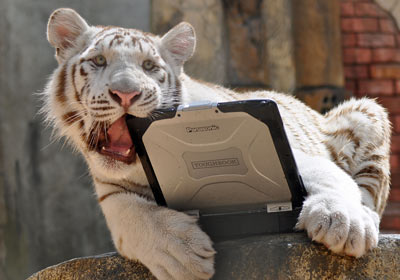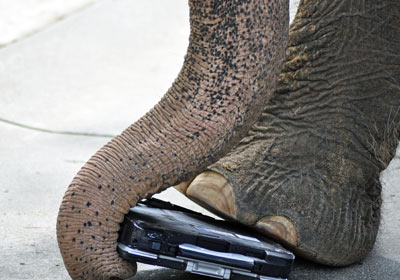Don’t believe manufacturers’ claims. We put Panasonic’s Toughbook through real survival tests.

BURLINGAME, Calif. — Call it the James Bond of laptops.
We dropped the Panasonic CF-30 “Toughbook,” kicked it, stood on it and tried to back over it with a Volkswagen JettaTDi. (That left a mark–on the pavement.)
We poured Diet Coke on the keyboard. Then we used the lid to crush the can.
You might think this is unnecessary testing for a laptop. Advertising is always brimming with over-the-top claims. We’ve heard about “durable” notebooks before. But the ones we lug to press conferences seem to be as touchy as a bunch of squirrels. Surely, Panasonic’s claims of toughness are, well, over-the-top.
We found, however, that Panasonic’s Toughbook performed as promised. Fair enough. So we came up with some tests that were decidedly unfair.
We used the Panasonic Toughbook to serve Doritos. Then we crushed the chips to dust between the keyboard and the screen, the same screen we used as a dartboard. The darts poked holes in the screen’s protective coating, but the display underneath remained undamaged. Not a single dead pixel.
So we presented the $3,460 Toughbook to Nalin, a white tiger who lives at Six Flags Discovery Kingdom in Vallejo, Calif. Nalin treated it like a cat toy, knocking it to the ground, gnawing on the screen and licking every inch of its surface. He must have smelled those Doritos.
The tiger chewed off five keys, but that turned out to be just cosmetic. We could still type without them, and were able to glue four back on later (we made sure Nalin didn’t swallow anything). The fifth just snapped back into place.

Next, Liz, a 10,000-pound Asian elephant, stepped on it, stood on it, dropped it onto a concrete slab, stood on it again–balanced on three legs–and then tossed it around some more. Liz put two small cracks in the laptop’s magnesium alloy lid and popped the hard drive out.
The drive slid right back in to the Toughbook’s chassis, which rebooted without a glitch. The screen was undamaged, although it was hard to see through the tiger hair and congealed drool.
That’s when we remembered: We’re allergic to cats.
Five days later, we turned from tests to something better described as execution: We took the laptop to the Jackson Arms firing range in South San Francisco to shoot it with a Ruger Mark III .22 pistol from 15 yards.
Dell declined to loan us a rugged laptop to shoot, saying they didn’t have the “inventory excess to participate this time around.”
Panasonic, meanwhile, was about to have one less notebook. We removed the battery to minimize the mess, and aimed.
Goodbye, Mr. Toughbook.
Or so we thought. We put a bullet through the laptop. Then we booted it up. We were able to log in. Our test file was still there. The screen had a hole in it, but was still usable.
Spooky. Panasonic has built a laptop that was starting to look more like Grigori Rasputin than James Bond. It took cyanide, a stabbing, a beating and four bullets before the Russian mystic was finally drowned in the icy River Neva. Anyone got some holy water?
Don’t call the Toughbook the anti-Christ, however; call it the anti-netbook. Panasonic’s customers, typically cops and firefighters, the military and businesses want to keep their ownership costs low over the entire lifetime of their gear. No matter what.
As a result, the CF-30 is the product of a business model that’s the opposite of that behind today’s wave of cheap, disposable netbook computers.While the $300 machines you’ll find for sale at Best Buy are available in a wide array of colors and styles, they all come from the same place: low-cost contract manufacturers.
Panasonic, by contrast, was an electronics manufacturer long before it got into the computer business. It builds many of the components you’ll find in other companies’ laptops, including displays and batteries, says Rance Poehler, who leads Panasonic’s North American computer business.
So rather than outsourcing, Panasonic can put its factories to work building not just tough laptops, but tough parts for those laptops. The Toughbook 30’s hard drive, for example, is itself a minor marvel of engineering: It’s designed to withstand being ripped out at a moment’s notice in the field and is encased in a padded metal shell all its own.
That kind of durability costs more, but customers say it pencils out well enough that they’d buy a Toughbook over a typical notebook. Morris Materials Handling, which sells and services overhead cranes for heavy industry, buys refurbished Panasonic 18s that have seen use in the military for a little more than half the price of new ones. The laptops aren’t indestructible–a 50-foot drop from a crane did one in–but the technician was able to pop out the hard drive, slap it into a new unit, and get back to work.
Durability, however, is about more than taking a drop or a surviving an elephant attack. Henry King at ArborMetrics Solutions, which keeps trees and other foliage out of the way for utilities across the U.S., has deployed 70 Toughbooks. Just the road vibrations caused by putting a laptop in a car and driving 40,000 to 50,000 miles a year to service its customers’ infrastructure has killed many laptops, King says. By contrast, Panasonic’s hard drives can suck it up.
As for our test laptop, it had been through enough. It was time to put the beast down. The Toughbook CF-30 is elephant- and tiger-resistant. It can take a .22 at close range and continue working. We needed something that would leave a bigger hole.
So we borrowed a Springfield 1911 in .45 ACP. Most cops use comparatively dinky 9-millimeter pistols. This classic 39-ounce piece is more hand cannon than handgun.
A shot with the 1911 from 15 yards took the Toughbook down. To be sure it didn’t stagger back up, we followed up with a .44 magnum revolver and a solid lead slug from a 12-gauge shotgun. Then we packed up the Toughbook and sent it back to Panasonic.
Brian Caulfield, 06.23.09, 06:15 PM EDT
Source: Forbes